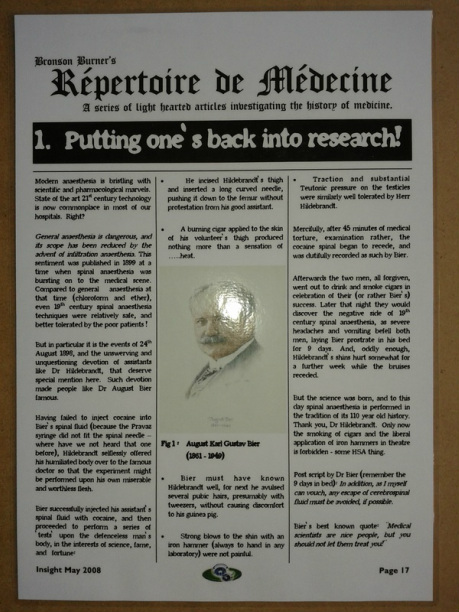Does this hurt?
The amusing birth of spinal anaesthesia by Quentin Smith
(Published as 'Putting one's back into research' in Insight May 2008)
Modern anaesthesia is bristling with scientific and pharmacological marvels. State of the art 21st century technology is now commonplace in most of our hospitals. Right?
General anaesthesia is dangerous, and its scope has been reduced by the advent of infiltration anaesthesia. This sentiment was published in 1899 at a time when spinal anaesthesia was bursting on to the medical scene. Compared to general anaesthesia at that time (chloroform and ether), even 19th century spinal anaesthesia techniques were relatively safe, and better tolerated by the poor patients !
But in particular it is the events of 24th August 1898, and the unswerving and unquestioning devotion of assistants like Dr Hildebrandt, that deserve special mention here. Such devotion made people like Dr August Bier famous.
Having failed to inject cocaine into Bier’s spinal fluid (because the Pravaz syringe did not fit the spinal needle – where have we not heard that one before), Hildebrandt selflessly offered his humiliated body over to the famous doctor so that the experiment might be performed upon his own miserable and worthless flesh.
Bier successfully injected his assistant’s spinal fluid with cocaine, and then proceeded to perform a series of ‘tests’ upon the defenceless man’s body, in the interests of science, fame, and fortune:
But the science was born, and to this day spinal anaesthesia is performed in the tradition of its 110 year old history. Thank you, Dr Hildebrandt. Only now the smoking of cigars and the liberal application of iron hammers in theatre is forbidden - some Health & Safety thing.
Post script by Dr Bier (remember the 9 days in bed): In addition, as I myself can vouch, any escape of cerebrospinal fluid must be avoided, if possible.
The amusing birth of spinal anaesthesia by Quentin Smith
(Published as 'Putting one's back into research' in Insight May 2008)
Modern anaesthesia is bristling with scientific and pharmacological marvels. State of the art 21st century technology is now commonplace in most of our hospitals. Right?
General anaesthesia is dangerous, and its scope has been reduced by the advent of infiltration anaesthesia. This sentiment was published in 1899 at a time when spinal anaesthesia was bursting on to the medical scene. Compared to general anaesthesia at that time (chloroform and ether), even 19th century spinal anaesthesia techniques were relatively safe, and better tolerated by the poor patients !
But in particular it is the events of 24th August 1898, and the unswerving and unquestioning devotion of assistants like Dr Hildebrandt, that deserve special mention here. Such devotion made people like Dr August Bier famous.
Having failed to inject cocaine into Bier’s spinal fluid (because the Pravaz syringe did not fit the spinal needle – where have we not heard that one before), Hildebrandt selflessly offered his humiliated body over to the famous doctor so that the experiment might be performed upon his own miserable and worthless flesh.
Bier successfully injected his assistant’s spinal fluid with cocaine, and then proceeded to perform a series of ‘tests’ upon the defenceless man’s body, in the interests of science, fame, and fortune:
- He incised Hildebrandt’s thigh and inserted a long curved needle, pushing it down to the femur without protestation from his good assistant.
- A burning cigar applied to the skin of his volunteer’s thigh produced nothing more than a sensation of …..heat.
- Bier must have known Hildebrandt well, for next he avulsed several pubic hairs, presumably with tweezers, without causing discomfort to his guinea pig.
- Strong blows to the shin with an iron hammer (always to hand in any laboratory) were not painful.
- Traction and substantial Teutonic pressure on the testicles were similarly well tolerated by herr Hildebrandt.
- Mercifully, after 45 minutes of medical torture, examination rather, the cocaine spinal began to recede, and was dutifully recorded as such by Bier.
But the science was born, and to this day spinal anaesthesia is performed in the tradition of its 110 year old history. Thank you, Dr Hildebrandt. Only now the smoking of cigars and the liberal application of iron hammers in theatre is forbidden - some Health & Safety thing.
Post script by Dr Bier (remember the 9 days in bed): In addition, as I myself can vouch, any escape of cerebrospinal fluid must be avoided, if possible.

